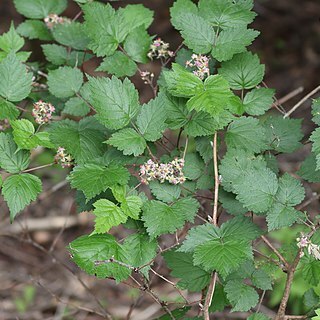Shrubs scandent, 1–4 m tall. Branchlets reddish brown or purplish brown, with soft hairs and sparse, needle-like prickles or nearly unarmed, old branches grayish brown, with sparse prickles broadened basally. Leaves imparipinnate, often 3-foliolate, rarely 5-foliolate; petiole 3–7 cm, petiolule of terminal leaflet 1.5–4 cm, lateral leaflets shortly petiolulate or subsessile, petiolules and rachis pubescent, with sparse, curved minute prickles; stipules linear, to 1.2 cm, pubescent, margin entire; blade of leaflets variable in shape, terminal leaflet broadly rhombic-ovate or elliptic-ovate, base rounded to subcordate, margin often pinnate-lobed, apex acuminate, lateral leaflets obliquely elliptic or ovate, 4–9(–11) × 3–7(–9) cm, abaxially densely gray tomentose, adaxially appressed pubescent or glabrescent, base cuneate to rounded, margin unevenly coarsely serrate, often lobed, apex acute. Inflorescences terminal or axillary, corymbose, (2–)3–4.5 cm, shorter than petiole, several to more than 20-flowered; rachis and pedicels pubescent, with sparse, needle-like prickles; bracts linear, 7–10 mm, pubescent. Pedicel 6–12 mm. Flowers ca. 1 cm or more in diam. Calyx abaxially densely pubescent; sepals often reflexed after anthesis, lanceolate, (4–)5–8 × 3–4 mm, inner sepals with tomentose margin, apex acute to shortly acuminate. Petals white or pink, obovate, suborbicular, or elliptic, 5–6 × 4–5 mm, premorse, base slightly pubescent and shortly clawed. Stamens many, ca. as long as petals. Styles glabrous; ovary pilose. Aggregate fruit purplish black, compressed globose, 6–8 mm in diam., glabrous; pyrenes triangularly ovoid-globose, rugose. Fl. Apr–May, fr. Jul–Aug. 2n = 14*.
More
A shrub. It loses its leaves during the year. The branches are long and slender. They have a dense covering and a few prickles. The leaves have 3 leaflets and the end leaflet is broadly oval. It is 6-7 cm long by 5-6 cm wide. There are shallow lobes above the middle. The side leaflets are smaller. The flowers are white or pink and 1 cm across. They are in loose clusters. The fruit are blue to black and 1 cm across.
Slopes, forest understories in montane valleys, riverbanks, mixed forests, roadsides and broad-leaved evergreen forests; at elevations from 600-3.600 metres.
More
It is a temperate plant. In the Himalayas it grows between 2,200-2,800 m altitude. In Sichuan and Yunnan.
Can be grown by cuttings or seedlings. Seeds needs stratification.

